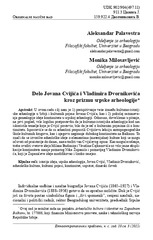Приказ основних података о документу
The Work of Jovan Cvijic and Vladimir Dvornikovic through the Prism of Serbian Archaeology
| dc.creator | Palavestra, Aleksandar | |
| dc.creator | Milosavljević, Monika | |
| dc.date.accessioned | 2021-10-12T12:12:29Z | |
| dc.date.available | 2021-10-12T12:12:29Z | |
| dc.date.issued | 2015 | |
| dc.identifier.issn | 0353-1589 | |
| dc.identifier.uri | http://reff.f.bg.ac.rs/handle/123456789/2051 | |
| dc.description.abstract | reason to consider the works of Jovan Cvijic and Vladimir Dvornikovic. However, if we consider the history of ideas that have fundamentally determined the course of Serbian archaeology, it is relevant to examine the contributions of other disciplines and their key representatives. In the case of Serbian archaeology, the estimation of interdisciplinary transfers of ideas must be approached critically and with great caution, due to the deeply rooted tradition of not explicating the theoretical and methodological base of research. In other words, well into the 20th century, archaeologists have very rarely referred to authors from other fields of research, especially when dealing with general social phenomena. Serbian archaeology has tended to be a-theoretical, and the ideas of social development, social dynamics, or the rules of social behaviour have been considered as "implicit knowledge", that need not be explained. However, these knowledges are counted upon, and are still considered as indubitable; there lies the power of "common points", whose origins and genesis are very hard to discern. In this case study, the aim is to: 1) reconsider the link between the culture-historical archaeology in Serbia and cultural belts of Jovan Cvijic; and then to 2) attempt to understand the genealogy of the idea of continuity in Serbian archaeology. In other words, we shall challenge the apparently very logical supposition that our culture-historical archaeology has used the foundations laid by Jovan Cvijic, both in the case of cultural belts and of continuity. It will be demonstrated that archaeologists have skipped the lesson of Cvijic's anthropo-geographical school of cultural circles, as well as his rejection of deep continuity in the Balkans. This means that the source of the archaeological idea of the elements of (material) culture that may be preserved from prehistory to the present, must be sought for in another direction, outside the work of Cvijic. One possible solution is to acknowledge the worlds of ideas of Milan Budimir and Veselin Cajkanovic, along with very explicit ideas of continuity of less known Niko Zupanic and more prominent Vladimir Dvornikovic, who modified and widely disseminated the ideas of Zupanic. | en |
| dc.publisher | Univerzitet u Beogradu - Filozofski fakultet - Odeljenje za etnologiju i antropologiju, Beograd | |
| dc.relation | info:eu-repo/grantAgreement/MESTD/Basic Research (BR or ON)/177008/RS// | |
| dc.rights | openAccess | |
| dc.rights.uri | https://creativecommons.org/licenses/by/4.0/ | |
| dc.source | Etnoantropološki problemi | |
| dc.subject | Vladimir Dvornikovic | en |
| dc.subject | substrate | en |
| dc.subject | Serbian archaeology | en |
| dc.subject | Jovan Cvijic | en |
| dc.subject | history of ideas | en |
| dc.subject | Dinara type | en |
| dc.subject | culture belts | en |
| dc.subject | continuity | en |
| dc.subject | archaeological culture | en |
| dc.title | The Work of Jovan Cvijic and Vladimir Dvornikovic through the Prism of Serbian Archaeology | en |
| dc.type | article | |
| dc.rights.license | BY | |
| dc.citation.epage | 649 | |
| dc.citation.issue | 3 | |
| dc.citation.other | 10(3): 619-649 | |
| dc.citation.rank | M24 | |
| dc.citation.spage | 619 | |
| dc.citation.volume | 10 | |
| dc.identifier.doi | 10.21301/eap.v10i3.4 | |
| dc.identifier.fulltext | http://reff.f.bg.ac.rs/bitstream/id/847/2048.pdf | |
| dc.identifier.wos | 000436260600004 | |
| dc.type.version | publishedVersion |

